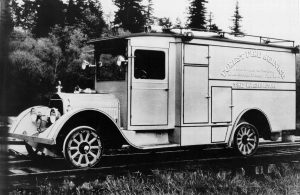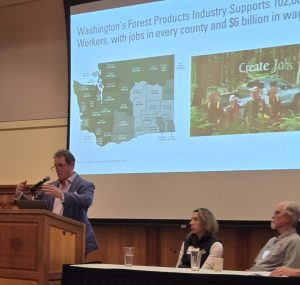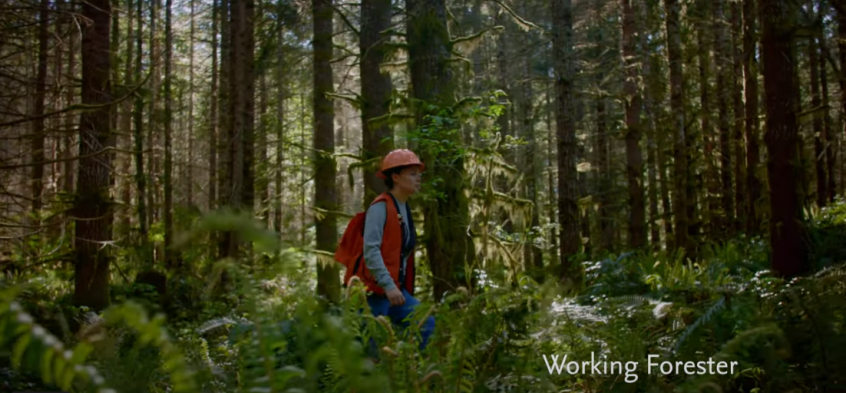 At the 125th anniversary celebration of the Society of American Foresters, Cindy Mitchell and Jason Spadaro of the Washington Forest Protection Association offered a reminder that forestry has always been a story of adaptation to forest policies that shape how working forests are managed.
At the 125th anniversary celebration of the Society of American Foresters, Cindy Mitchell and Jason Spadaro of the Washington Forest Protection Association offered a reminder that forestry has always been a story of adaptation to forest policies that shape how working forests are managed.
Cindy began by taking the audience back to WFPA’s roots when the 1902 catastrophic Yacolt Burn devastated over 370 square miles of Southwest Washington, and many lives were lost. That disaster led private landowners to create the state’s first coordinated fire patrol, forming the Washington Forest Fire Association in 1908, and the beginning of what became WFPA. From those early beginnings, forestry in Washington evolved alongside the state itself—through treaties with tribes, the establishment of state trust lands, and the building of a timber economy that funded schools, communities, and the growth of the Pacific Northwest.
Landmark environmental laws in the 1970s, like the Clean Water Act and Endangered Species Act, redefined how forests could be managed. New legal decisions reaffirmed tribal treaty rights, and changing public expectations around habitat and water quality reshaped forest practices. Through it all, forest landowners adapted—not only responding to new rules but helping to create solutions like the Timber, Fish & Wildlife Agreement and the Forests & Fish Law, which today guide much of Washington’s forest stewardship.
Jason Spadaro then shifted the view to the present and future. While over half of Washington is forested, less than half are working forests, and how we manage these forests—and for what purposes—continues to evolve. State and private working forests produce most of Washington’s wood products, while federal forests face reduced harvests, growing wildfire risk, and mounting restoration challenges.

Jason explained that forest policy decisions have tangible effects: on timber supply, on the ability to produce sustainable wood products, and on rural economies that depend on steady log flow. Yet despite the challenges, there are real opportunities. Actively managing forests can increase timber growth, reduce wildfire risk, and keep our rural communities alive. New technologies like mass timber offer ways to build stronger, greener cities using renewable wood instead of concrete and steel. Modern sawmills can cut lumber faster, smarter, and with less waste. By investing in biofuels, wood-based products, and a circular bioeconomy, we can replace fossil fuels with renewable materials grown right here at home. Washington has the forests, the people, and the know-how.
Forest policies of the future should support the advances in forest science, and innovation to meet the growing demand for climate-smart building materials, but we need to remind policymakers that sustainably managed forests are a solution:
- We have plenty of inventory to increase our timber harvest volumes, under current environmental regulations.
- Washington is an important supplier of the country’s log and lumber demand.
- Harvest supports forest health, reduces wildfire risk, and enhances forest resiliency.
- Managed forests absorb carbon 2x faster and store 3x more carbon/acre in both forests and wood products than unmanaged USFS forests.
The past 125 years show that Washington’s forests have endured fire, economic shifts, regulatory change, and public debate. Looking ahead, the challenge is to ensure they continue to provide all their benefits—clean water, wildlife habitat, renewable wood, carbon storage, and community support—through thoughtful management rooted in science, collaboration, and respect for the land’s full potential.
As Cindy and Jason reminded the audience, forestry’s future will depend on the same spirit that guided its past: staying at the table, adapting to change, and working together to meet the needs of both people and forests.

On April 6, 1908, 22 timber companies incorporated the Washington Forest Fire Association. The life of the association is set at 50 years. The four founding members are Merrill-Ring Bliss, Port Blakely Mill, Simpson Logging, and Weyerhaeuser Timber Company. In 1957 the Board of Trustees decided that the Association continued to serve a very essential purpose to forest landowners and stopped focusing on fire fighting. Then changed its name to Washington Forest Protection Association to focus on public policy matters. “The change of name has some significance. The problem of forest protection goes beyond fire prevention and suppression… for it matters little to the forest landowner in what manner their equity is decreased. The objective is the safety of forest equities…the purpose is complete protection.” (1957 WFPA Annual Report)
